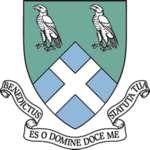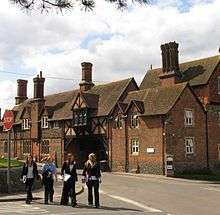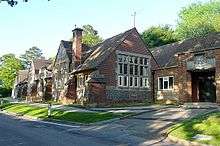Bradfield College
 | |
| Motto |
Benedictus es, O Domine doce me Statuta Tua (You are blessed, Lord: teach me your laws) |
|---|---|
| Established | 1850 |
| Type |
Independent boarding school Public school |
| Religion | Church of England |
| Headmaster | Dr. Christopher Stevens |
| Second Master | Kevin Collins |
| Founder | Rev. Thomas Stevens, Rector and Lord of the Manor of Bradfield |
| Location |
Bradfield Berkshire RG7 6AU England |
| DfE URN | 110121 Tables |
| Staff | 120 (approx.) |
| Students | 731 |
| Gender | Mixed |
| Ages | 13–18 |
| Houses | 12 |
| Colours |
Light blue Eton Blue |
| Publication |
"The Bradfieldian" 'Bradfield News The Old Bradfieldian Horizons Bradfield Arts |
| Former pupils | Old Bradfieldians |
| Website |
www |




Bradfield College is a British co-educational independent school for boarding and day pupils, located in the small village of Bradfield in the English county of Berkshire. It is noted for producing plays in Ancient Greek and its Greek Theatre.
The school is a member of the Rugby Group, which also includes Harrow School, Wellington College and Charterhouse School.
The college was founded in 1850 by Thomas Stevens, Rector and Lord of the Manor of Bradfield. It has around 470 male and 260 female pupils.
Overview
According to the Good Schools Guide, the "Pastoral, extra-curricular and academic aspects [are] all strong in a very beautiful setting. The school is unusually family-friendly and with exceptional boarding."[1]
The school, which admits pupils between the ages of 13–18, has been fully co-educational since September 2005. All first years pupils (Fourth Formers) enter a first year boarding house (Faulkner's) and then, from the second year (known as the Shell), they move to their main boarding houses for the remaining four years.
The school motto is the Latin; Benedictus es, O Domine doce me Statuta Tua which means "You are blessed, Lord, Teach me your Laws."
History
Bradfield College was founded in 1850 by Thomas Stevens. Stevens had inherited the parish from his father in 1842, having been in his family for four generations. As a tribute to his father, he set about restoring the church. Sir Gilbert Scott (one of whose architect sons, John Oldrid Scott, was later to marry Thomas Stevens's eldest daughter, Mary Anne) was commissioned to effect the restoration. It was decided that the majority of the church, except the tower, should be demolished and rebuilt in a style influenced by that of gothic architecture. After the completion of the church in 1848, Stevens saw it fit to arrange a choir. While the whole village were able to sing, they were not felt to be of a high enough standard. It was proposed that a college be established at Bradfield, to be called St. Andrew's College. The college was to be for the education of a limited number of boys between the ages of 8 and 12, with all to be from modest backgrounds. Their education was to be based upon 'true Church principles', with focus to be paid on reading, writing, mathematics, and music, and later on, classics and history.
The first headmaster to be appointed was Dr F. B. Guy in 1852. The headmaster was to be under control of the college Warden, who would be responsible for the principle governance of the college. Soon after the formal establishment of the college, all references to 'true Church principles' were dropped, with the focus now being on providing an education like that of other British Public Schools.[2]
In 2005 Bradfield College was one of fifty of the country's leading independent schools which were found guilty of running an illegal price-fixing cartel which had allowed them to drive up fees for thousands of parents.[3] Each school was required to pay a nominal penalty of £10,000 and all agreed to make ex-gratia payments totalling three million pounds into a trust designed to benefit pupils who attended the schools during the period in respect of which fee information was shared.[4]
The Greek Play
Bradfield is renowned for its Greek plays and Greek Theatre. The first Greek play, Alcestis, was performed in the original language in 1881. The play was put on by Headmaster, Dr Herbert Branston Gray[5] to save the school from bankruptcy and was inspired by the performance of Agamemnon at Balliol College, Oxford in 1880, directed by F. R. Benson, who stage-managed the Bradfield performance and took the role of Apollo.
The Greek play is normally performed on a three-year rota. The students who act in them receive no formal training in speaking Ancient Greek, and have only nine months to learn the lines and direction, while keeping up with their other studies.
The Greek Theatre was based on that at Epidaurus and built in a disused chalk pit. It opened in 1890 with a performance of Antigone. The 2006 play, Euripides’s Medea, directed by John Taylor, was noted for including the addition of projected subtitles and incorporating the orchestra into the skēnē, using a ramp covered in sand and flooded to symbolise the sea and Medea's situation of being "between places".
The Greek Theatre closed in 2009 for restoration and, following a £1.3 million appeal, reopened with a performance of Antigone on 20 June 2014.[6] The College decided not to rebuild the Victorian temple in the middle of the performing area because such "temples" are not true to the design of ancient Greek amphitheatres. The smaller skēnē creates space, making the performance of the plays easier and enabling the theatre to be used for other drama including Shakespeare. The 2009 Greek play, Oedipus by Sophocles, was performed in the College's recently refurbished Big School theatre.
Appointment of new Headmaster
Dr. Christopher Stevens is Headmaster in succession to Simon Henderson, appointed by Council from September 2015. Dr. Stevens was educated at Tunbridge School and then read Modern and Medieval Languages at Cambridge University, from where he received his MA. He began his teaching career as a College Lecturer while researching for a DPhil in Italian literature at Oxford University. He then established a school in France for Ashdown House, the boarding Prep School in Sussex. He joined Uppingham School in 1997 where he was Master-in-charge of cricket and a Housemaster for nine years. In 2011 he moved to Marlborough College, and was Second Master until his appointment at Bradfield.
Other information
In Summer 2009 Bradfield received outstanding inspection reports from the Independent Schools Inspection team and Ofsted body of inspectors.
In September 2010 the Blackburn Science Centre was opened. The new building includes green elements such as a bio-mass boiler, green roof and solar panels.
From September 2012 Bradfield offers the International Baccalaureate Diploma Programme (IBDP) alongside the traditional AS/A Level pathway.
The oldest building is College gateway, which incorporates part of a barn of 1382. The wrought iron was made by the village blacksmith.
Houses
Bradfield has 12 boarding houses in total. All first years pupils (Fourth Formers) enter a first year boarding house (Faulkner's) and then, from the second year (known as the Shell), they move to their main boarding houses for the remaining four years.
| House | Abbr. | Hsm. | Gender |
|---|---|---|---|
| Faulkner's | L | V. Rae & J. Saunders | Female & Male |
| Loyd House | A | J. Preston | Male |
| Army House | C | A. Golding | Male |
| D House (House on the Hill) | D | R. Sanford | Male |
| Stone House | E | P. Armstrong | Male |
| Hillside | F | C. Carlier | Male |
| G House (House on the Hill) | G | T. Goad | Male |
| The Close | H | J. Hanbury | Male |
| Palmer House | I | C. Major | Female |
| Armstrong House | J | S. Ronan | Female |
| Stevens House | K | C. van der Westhuizen | Female |
| Stanley House | M | C. Kirby | Female |
Notable Old Bradfieldians
Notable staff
- Weston Bate, Australian historian.
- Anthony Chenevix-Trench, headmaster 1955-1963, subsequently headmaster of Eton College and Fettes College
- Harold Costley-White, Anglican priest and headmaster, subsequently head of Westminster School
- Albert David (1867–1950) Anglican priest, schoolmaster and bishop.
- Marshal of the Royal Air Force Charles Elworthy, Baron Elworthy, school governor.
- Sir Ronald Aylmer Fisher (1890–1962) statistician, evolutionary biologist, geneticist, and eugenicist.
- Ronald Groves
- John Harvey, cricket coach and groundsman
- Henry Hayman, headmaster from 1868-1869
- Michael Hoban, headmaster 1964-1971, subsequently headmaster of Harrow School
- Vinnie Jones, formerly worked in the college kitchens.
- General Sir Peter Leng MC, British Army Officer and Master-General of the Ordnance.
- Bertram Luard-Selby (1853–1918), composer and cathedral organist.
- Denis Richards, teacher and RAF historian.
- Major-General Michael Scott, (born 1941) is a British Army officer and former Military Secretary (United Kingdom)
- John Shaw (former field hockey player and coach)
- Christopher Steel (1938–1991) British composer of contemporary classical music.
- William Beach Thomas, later a war correspondent and writer on rural affairs
- Jonathan Saunders, English teacher and Housemaster of Faulkner's.
See also
References
- ↑ "Archived copy". Archived from the original on 2008-12-11. Retrieved 2008-10-07.
- ↑ A History of Bradfield College (1900)
- ↑ Independent schools face huge fines over cartel to fix fees - Times Online
- ↑ The Office of Fair Trading: OFT names further trustees as part of the independent schools settlement Archived June 10, 2008, at the Wayback Machine.
- ↑ ODNB article on Gray, Herbert Branston (1851–1929)
- ↑ "Tragic tale marks new start for amphitheatre" Henley Standard 16 June 1914
External links
| Wikimedia Commons has media related to Bradfield College. |
- Bradfield College website
- Profile at the Good Schools Guide
- Schoolsguidebook
- Ofsted Boarding report, 2005
- Independent Schools Inspectorate report, 2003
- Old Bradfieldians Society Website
Coordinates: 51°26′57″N 1°07′51″W / 51.44919°N 1.13073°W